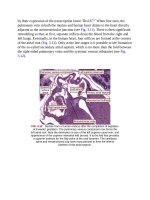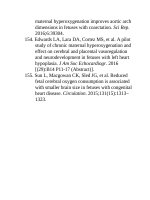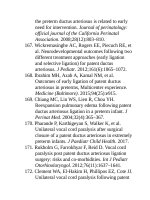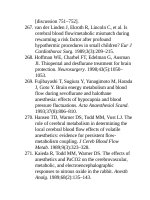Andersons pediatric cardiology 1848
Bạn đang xem bản rút gọn của tài liệu. Xem và tải ngay bản đầy đủ của tài liệu tại đây (82.78 KB, 3 trang )
surgicalintervention.Ingeneralthesearechildrenwithunobstructedsystemic
bloodflowandrestrictedpulmonarybloodflow;inthemthephysiologyresults
inadequatesystemicDO2,a“protected”pulmonaryvascularbedwithnormal
pulmonaryarterypressures,andnosignificantobstructiontosystemicor
pulmonaryvenousreturn.Thisismostcommonlyseeninpatientswithtricuspid
atresia(withatrioventricularandventriculoarterialconcordance)andarestrictive
ventricularseptaldefectandinpatientswithisomerismandnativeobstructionto
pulmonarybloodflow(seeChapter69).Thesepatientsrequirefrequent
monitoringinearlyinfancyforadequateoxygenationaswellastoconfirmthat
pulmonaryarterypressuresarelow;however,asmallnumberofbabiesborn
withafUVHmaynotrequiresurgeryuntilaplannedsuperiorcavopulmonary
connection(SCPC)(seelater).
WhenIsItSafetoLeavetheOperatingRoom?
Residuallesions,inadequatelypalliatedanatomy,isassociatedwithincreased
mortalityandmorbidityinpatientswithafUVH.102Palliativeproceduresfor
patientswithfUVHareamongthemostchallengingprocedures.Thepatientwill
leavetheoperatingroomwithamultidistributionratherthannormalin-series
circulation.Itisessentialthatthepalliativeprocedureachievetheanatomicgoal
andassessmentofthesuccessoftheprocedureisessentialpriortoleavingthe
operatingroom.Toolstoassesstheoutcomeofpalliationwillincludeevaluation
ofhemodynamics,fillingpressure,bloodpressureandpulseoximetry,and
additionallesion-specificmeasuressuchasmeasurementofbloodpressureinthe
upperandlowerextremitiesaftercoarctationrepair.Forthepatientsundergoing
mainpulmonaryarterybanding,inadditiontoassessmentofhemodynamics,
measurementofdistalpulmonaryarterypressure,echocardiographyandarterial
andvenousoxygensaturationandpO2maybeneeded.
Despitetherelativesimplicityoftheprocedurethesystemic-to-pulmonary
arteryshuntisoneofthehigher-riskpalliativeprocedures.103Ifashuntistoo
large,thepatientcanhaveexcessivepulmonarybloodflowattheexpenseof
systemicbloodflow.104Inaddition,ashuntthatistoolargecanresultin
diastolichypotension,thuscompromisingcoronarybloodflow.104Iftheshuntis
toosmall,thepatientwillcontinuetohaveexcessivehypoxemia.Intraoperative
assessmentoftheadequacyofashuntischallenging.Theshuntisconstructedin
ananesthetizedpatient;asaconsequence,VO2ismarkedlyreduced.Saturations
willbehigherintheanesthetizedstatethanwhenthepatientisawake.
Assessmentoftheshuntiseasieriftheductusisclosedatthecompletionofthe
procedure.Forthepatientundergoingplacementofasystemic-to-pulmonary
arteryshunt,thegoalissustainedreliefofhypoxemia,andevaluationwill
includeboththehemodynamicswithspecialattentiontothediastolicblood
pressureaswellasarterialandvenousoxygensaturationandpO2.
Closedpalliativeprocedures(performedwithouttheuseofcardiopulmonary
bypass)—suchascoarctationrepair,pulmonaryarterybanding,andconstruction
ofasystemic-to-pulmonaryarteryshunt—maybecomplicatedbythe
developmentofarestrictiveatrialseptaldefect.Theadequacyoftheatrialseptal
defectshouldbeevaluatedpreoperativelyandplansfordefinitivemanagement
madepriortootherpalliativeprocedures.
ThegoalofNorwoodpalliationincludesreliefofsystemicoutflowtract
obstruction,creationofawidelypatentatrialseptalcommunication,andcreation
ofareliablesourceofpulmonarybloodflowthatrelieveshypoxemia,permits
growth,butdoesresultinheartfailure.Intraoperativeevaluationofthepatient
followingtheNorwoodprocedureischallenging.Inadditiontoassessmentof
hemodynamics—especiallybloodpressure,centralvenouspressureandpulse
oximetry—evaluationmayincludesimultaneousmeasurementofascendingand
descendingaorticbloodpressure,echocardiographicassessmentofsystolic
function,AVvalveregurgitation,sizeofatrialseptaldefect,andreliefofarch
hypoplasia.Measurementofsuperiorcavalveinsaturation,asurrogateofmixed
venoussaturationandNIRS,canprovideinformationonglobalDO2.
Identificationofresiduallesionssuchasimportantresidualarchobstructionora
restrictiveatrialseptaldefectshouldpromptthecliniciantoconsiderimmediate
correction.Theadequacyofthesourceofpulmonarybloodflowcanbemore
challenging.Excessivehypoxemiashouldpromptastepwiseevaluationas
outlinedearlier.Excessivepulmonarybloodflowcanbeidentifiedbyhigher
arterialsaturationandpO2,alongwithevidenceofreducedsystemicbloodflow
suchasreducedsuperiorcavalveinsaturation,reducedsomaticNIRSvalues,
andhypotension.Coronaryinsufficiencyisamajorcauseofmortalityafterthe
Norwoodprocedure.Althoughseverecoronaryinsufficiencyisobvious—dusky,
cyanoticmyocardiumandprofoundlydecreasedfunctionwithinabilitytowean
frombypass—thediagnosisofsubtlercoronaryinsufficiencyismore
challenging.Decreasedfunction,newAVvalveregurgitation,andECGchanges
arecommonfollowingtheNorwoodprocedureandcanoccureveninthe
otherwiseuncomplicatedpatient.Nevertheless,thesefindingsshouldprompt
evaluationofpatencyoftheconnectionofthenativeaorticandpulmonaryroots
witheitherechocardiographyorangiography.
PostoperativeConsiderationsintheNeonate
NeonatalsurgicalpalliationofthepatientwithfUVHmustprovidebotha
systemicandpulmonaryoutputsufficienttoprovideDO2forthepatient's
metabolicdemandsandtopromotehealing.Optimally,systemicoutflow
obstructionwillbecompletelyrelievedandarestrictedsourceofpulmonary
bloodflowwillbecreated.Thesourceofpulmonarybloodflow,althoughfixed
tosomedegree,mustbesufficientlylargetosupporttheinfanttothesecondstagepalliation.Evenintheoptimallypalliatedchild,theearlypostoperative
periodiscommonlymarkedbyperiodsofdecreasedtotaloutputfromthesingle
ventricle;thiscanmakeachievingsatisfactoryDO2challenging.Inaddition,
thereisapotentialforresiduallesionsoradditionalcomplicationsthataffectthe
goalofprovidingadequatesystemicDO2.Withinthisgroupofdiagnosesand
surgicalreconstructions,thereisproportionalhighermortalitythanother
congenitalheartsurgerypatients.Thechallengesofmanagingthisgroupof
patientshasspawnedthemultidisciplinaryCICU,whichisemblematicof
moderncongenitalheartprograms.ThesechallengesaresummarizedinBox
71.3.
Box71.3
KeyElementsofPostoperativeStabilization
andManagementoftheNeonateWitha
FunctionallyUniventricularHeart
■Bedsidepreparedness
■Invasivemonitoring
■Bleeding
■Delayedsternalclosure
■Assessmentofadequatesystemicoxygendelivery
■Mechanicalventilationandconsiderationsfortrachealextubation









